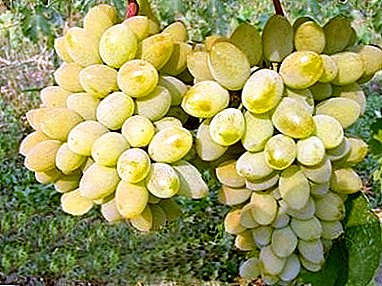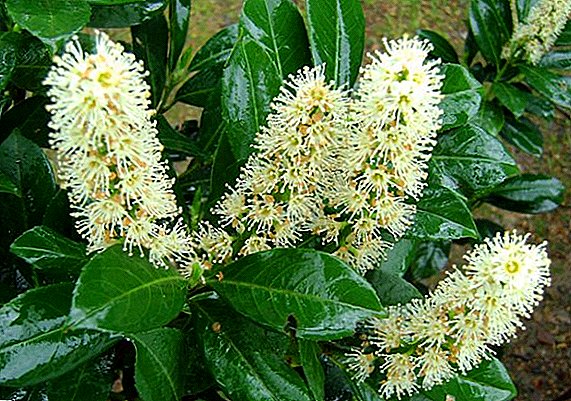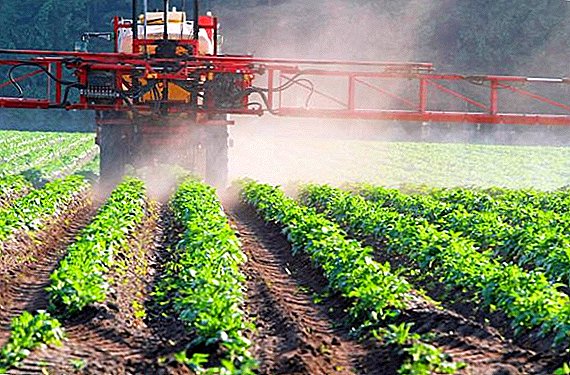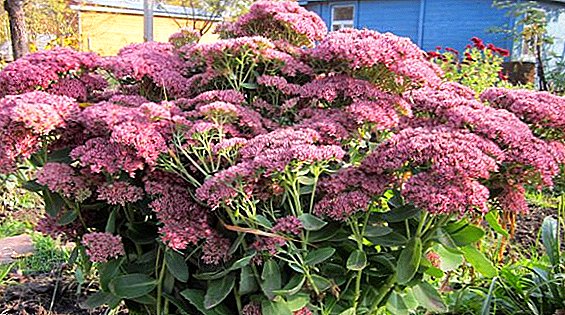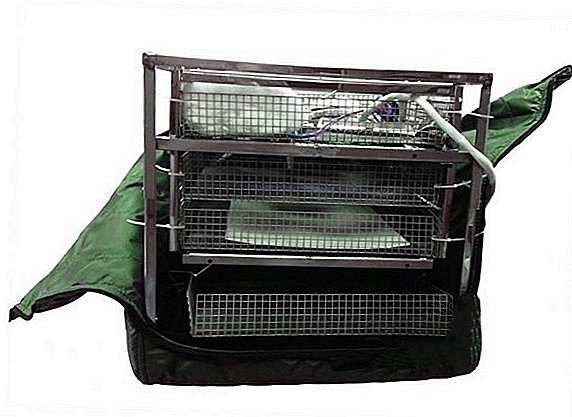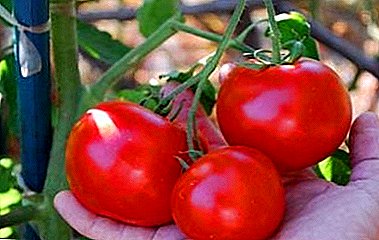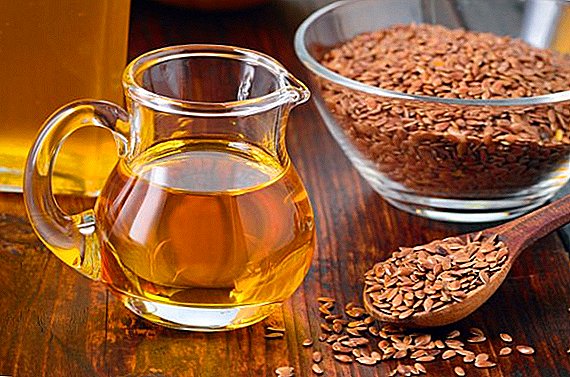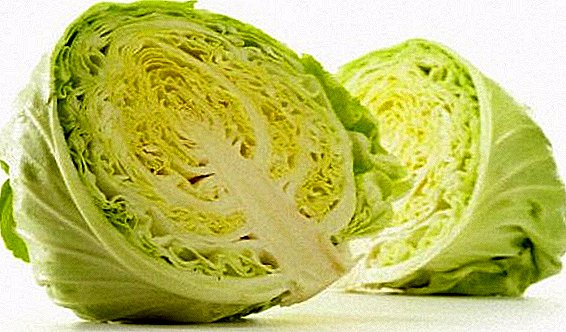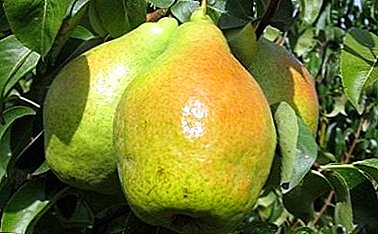
Among the huge variety of varieties pear "November" stands out by giving high yields of tasty and aromatic fruits with excellent keeping quality, almost not sick, and in the care of unpretentious and hardy.
In order for the pear “Noyabrskaya” to show itself in all its glory, it is only necessary to provide it with adequate care and reliable protection against pests, further in the article the description of agricultural technology, photo and video of fruits.
What kind of pears refers?
 Pear "November" is autumn skoroplodny grade, which has been cultivated in Russia since the second half of the 20th century.
Pear "November" is autumn skoroplodny grade, which has been cultivated in Russia since the second half of the 20th century.
The variety is quite popular among gardeners.
Fruits "November" able to be stored for a very long time, they are juicy, tasty and are good in compotes, jam, jams, preserves, confitures and dried.
Autumn varieties also include: Autumn Yakovleva, Samara Beauty, Tatyana, Fairy Tale and Larinskaya.
Breeding history and breeding region
"Noyabrskaya" was withdrawn by the Far Eastern Scientific Research Institute of Agriculture. The author of the variety is the breeder A.V. Bolognaev.
Scientist crossed wild frost Ussuri pear with a variety from Belgium "Winter Dean", as a result, and received a very hardy pear called" November ".
In 1950, it was first described, in 1958 it was transferred to tests at the state nursery, and in 1974 it was recommended for cultivation. in the Far East.
Most often, "November" can be found on south of Khabarovsk and around the coast of Primorsky Krai. Thanks high winter hardinesspear "Noyabrskaya" successfully grown and middle latitudes of Russia, as well as in the southern regions of Western Siberia.
In this region, such pear varieties are excellent: Hera, Cathedral, Krasnobakaya, Elena and Vernaia.
Pear "November": description of the variety and photos
 Variety pears "November" is tall tall tree with pyramidal crown, the description of the tree varies greatly with the fruits, as they are small in this make sure to see the photo below.
Variety pears "November" is tall tall tree with pyramidal crown, the description of the tree varies greatly with the fruits, as they are small in this make sure to see the photo below.
Skeletal branches of pear prone to thick branching and grow upward.
Fruits form on two- and three-year branches, which are shortened twigs and simple collars. The bark of the branches is colored greenish-maroon.
Pear leaves have an elongated oval shape with a pointed tip and slightly serrated edges. The upper part of the dense sheet plate is painted in dark green, and the bottom - in light green.
Variety "November" can not boast of large fruits. Their weight ranges from 64 g to 74 g. Pear shape ovoid with pronounced ribbing and most often slightly unequal. For the fruits of the "November" is characteristic dull, as if cut, lower base.
The top with irregularities and a small recess is also slightly sloping. The main color of the fruit - light green with a yellowish tinge. On the barrels, turned to the sun, a light burgundy blush usually appears.
The white flesh of the “November” pear is juicy and slightly oily. Her taste is sweet and sour and very pleasant, possessing a wonderful Fragrant aroma. For sweets "November" is not inferior to many popular varieties - the amount sugars in it at least 10.8%.
For more information about the pear variety "Noyabrskaya" in the photo below:




Watch the video where you see the fruits of the November November pear.
Specifications
High and stable yield - One of the many advantages of the variety.
When tested in state nurseries from trees of the variety "Noyabrskaya" at the age of 9 years old, 54.8 c / ha were collected, at the age of 10 years - 90.6 c / ha, and the highest yield was 212 centners / ha.
Excellent yields are also demonstrated by Krasulia, Lada, Lyubovytsa Yakovleva, Children's and Decakrinka.
 Variety is skoroplodnym and begins to yield in the 3rd or 4th year of life.
Variety is skoroplodnym and begins to yield in the 3rd or 4th year of life.
5 years after planting, pear fruit is already in full force.
A more rapid onset of fruiting can be achieved using the stock "Quince VA-29".
The variety is samobfruitny. The best pollinators of pears “Noyabrskaya” are autumn varieties, at the same time a blooming October or Yablokovidnaya pear tree and others.
Pear variety "November" ripen in late September. However, they acquire their wonderful taste only a month after harvest.
Worth saying that the fruits are very strong on the tree and do not fall down even with strong wind. In addition, they have good keeping quality and perfectly preserved until the New Yearand sometimes a little longer.
Although "November" is considered cold-resistant variety, in climatic zones with severe winters, it can freeze slightly, and therefore needs good insulation.
In the Amur region this variety is mainly grown in stanted form, which greatly facilitates its protection against too low winter temperatures.
Varieties of pear differ in excellent frost resistance: Rogneda, Rossoshanskaya beautiful, Fairy, Dyushes and Tonkovetka.
Planting and care
For landing it is desirable choose pear seedlings of two years old.
Special attention should be paid when buying roots - they must be well developed.
 Landing times can be like spring and autumn.
Landing times can be like spring and autumn.
Pears prefer to grow on dry and open ground with loamy or sandy soil.
On sandy soil, their productivity is reduced, and on over-wetlands pear trees die.
Groundwater should be at depth not less than 2.5 meters. Pear does not tolerate the shadow, so it is advisable to plant it at a distance not less than 4 meters from tall buildings.
The pit must be prepared in advance: for autumn planting - for 14-15 days, for spring - from autumn. The depth of the pit for high-growth pear "November" should be not less than 1 or even 1.2 m, and diameter - not less than 80 cm. Planting scheme for strong-growing trees - 4 by 5 m.
When preparing the pit, the upper layer of the earth is thick from 30 to 40 cm folded separately. It is used to prepare a fertile mixture.
In addition to the top sod layer, three dung buckets or vegetable humusabout two buckets sand, no more cups of superphosphate, about three tablespoons potassium sulfate.
 If the land at the site is acidic, one and a half kilograms is added to the fertile soil. the lime. The nutrient mixture is thoroughly mixed, it fills the pit by two thirds and left until the landing work.
If the land at the site is acidic, one and a half kilograms is added to the fertile soil. the lime. The nutrient mixture is thoroughly mixed, it fills the pit by two thirds and left until the landing work.
Before planting, a peg is driven into a hole (30 cm from the center). Then a mound is formed at the bottom, a sapling is placed on it and all roots are carefully straightened.
Next, the pit with the established tree is covered with earth, not forgetting that the root neck should be located 4 or 5 cm above the ground surface. Earth is good tamped and spilled with 3 or 4 buckets of water.
To do this, along the contour of the pit form an earthen groove for irrigation. Further, the area around the seedling mulch with peat, sawdust or humus, and the tree itself is tied to a peg using the figure eight method.
Young, not so long ago planted pears are watered on average 4 times a month. Enough buckets of warm water on every tree. Adult pear trees do not need frequent watering, as their strong root system grows deep and is able to extract water for itself.
The first watering is done in spring. before the kidneys swell, second - in late spring or early summer, after the pear has faded. With the beginning of leaf fall carried out third watering. On one tree at the age of 3 to 4 years old, at least 6 buckets of water are required.
Norm of water for more adult pear - 3 buckets per 1 sq. Meter of space under the crown. Sprinkling is considered the best irrigation method for pears.
Important! Pristvolny circle of pear tree throughout the season should be kept clean and protected from weeds. Also, the ground around the pear should be regularly loosened and mulched.
 Feeding pears can begin at the 2nd or 3rd year of her life.
Feeding pears can begin at the 2nd or 3rd year of her life.
Every two or three years, organic matter should be added in the form of mullein or slurry.
In the spring pear trees are fed nitrogen fertilizerand in the fall phosphorus-potassium.
During the flowering period it is recommended to spray the plants with a solution of sulfate (2%), urea (2%) or superphosphate (3%). Also pear useful foliar dressing urea after harvest.
Formative pruning pear "Noyabrskoy" is carried out immediately after planting. All branches are shortened by a third. Further throughout life, the tree needs sanitary and rejuvenating pruning.
Every spring the crown is thinned out, dry, diseased and damaged branches are removed. Two-year shoots are also shortened and three-year branches are cut off. It is important to always maintain the leading position of the center conductor.
If the branch is removed completely, it is undesirable to leave the hemp, as they impede the healing of wounds. When pruning pear trees, no more than 25% of all branches should be removed so as not to expose the tree to severe stress.
 In regions with cold winters, the pear “Noyabrskaya” can freeze slightly, therefore, needs protection.
In regions with cold winters, the pear “Noyabrskaya” can freeze slightly, therefore, needs protection.
Tree trunk circle for the winter they mulch with a thick layer of earth or horse humus.
The shtamb is wrapped with insulation material and then is lined with a coniferous fur twig or grid to protect against rodents.
Diseases and pests
Variety "November" resistant to fungal diseases and even to such a common pear disease as bacterial burn and //selo.guru/ptitsa/bolezni-p/gribkovye/parsha.html.
Resistance to diseases is distinguished by the following varieties: Chizhovskaya, Lel, Severyanka, Moscow Early and Chudesnitsa.
However she not insured against meeting with pests. The fight against voracious insects begins in early spring.
To prevent pests, the stumps and the skeletal branches of the pear are cleared of the old bark. Plant residues and carrion are also removed from the site in the fall.
These agrotechnical measures help to destroy overwintering nests and egg-laying pests. To collect the caterpillars of the pear moth on the lower parts of the trunk are established trap belts.
With a large number of pests, unfortunately, insecticides can not do. For the destruction of insects dangerous to the pear, several treatments are carried out (3 to 5 times per season).
Trees 1 or 2 times sprayed at the time of swelling of the kidneys, once - before flowering and after flowering, a couple of weeks after flowering and autumn. The number of treatments can be increased if the pears are protected from insects that produce two generations over the summer.
Vs aphids, pear sucker, leafworm, weevil and other sucking and leaf-eating insects effective Sumi-Alpha, Karbofos, Calypso, Iskra, Tsitkor, Fury, Kinmiks, Aktara, Decis, Agravertin.
Vs gall mite use "Sulfur colloid", "Fito-verm", "Demit", "Agravertin", "Nearon".
 Such important qualities for pears as good keeping quality of fruits and resistance to fungal diseases distinguish the “November” from other varieties.
Such important qualities for pears as good keeping quality of fruits and resistance to fungal diseases distinguish the “November” from other varieties.
Having planted it on your own plot, you will be able every year to enjoy high yields of healthy fruits and savor them even on New Year's holidays.



